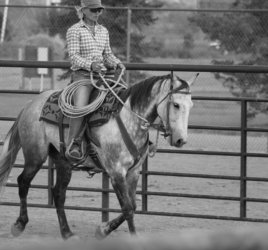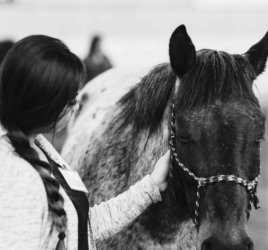In the Midst of Chaos
 For the past couple of weeks I have been moving the herd onto a neighbours pasture. Leaving horses out to eat 24/7 when the grass is in peak never works out well, so we head over late morning back each evening. The routine is slowly beginning to develop a measure of rhythm.
For the past couple of weeks I have been moving the herd onto a neighbours pasture. Leaving horses out to eat 24/7 when the grass is in peak never works out well, so we head over late morning back each evening. The routine is slowly beginning to develop a measure of rhythm.
The grass may be plentiful but the project manager in me appears when time is the scarce resource. Minimizing the number of trips by leading more than one horse seemed to be a sensible way to handle the process. Why take two horses when you can lead three or more?
Separating the herd always causes far more angst than you would think necessary. Without the non-verbal communication that holds them together the whinnying begins, actually, it’s more a deafening scream! To be clear we’re not talking about a long trip down the road, but simply one from our yard across the road onto the neighbours field. The drama doesn’t end when you get a batch of horses into the field but continues until each animal has arrived. The newly separated race around worried for their yet to arrive herd mates, causing even more frenzy among those left behind.
Needless to say the first few trips were more like a gong show than any sort of coordinated effort. It was if each individual had their own agenda: one excited about the adventure was charging ahead, switching sides and spinning around generating excitement and confusion; another seemingly suspect of the pending change would become an anchor a “ya but” for each step of the way and then there was the horse more concerned about how everyone else might impact them still not sure they wanted to be on the trip at all. I was trying to be the leader in the midst of chaos and had to develop a new strategy to stay alive. I needed the herd to respect me.
Horses like routine and any change will cause undue stress. I have often mentioned that when it comes to something new a horse always reverts to the most basic of values, their life. So change triggers the “Will I live or die?” reaction. The initial plan was to move half the herd over, one I soon altered as visions of animals desperate to connect and fences mixing in a bad way came to mind. Moving sixteen horses and one donkey meant more trips in the short term but the field would be grazed down faster ending the whole project sooner.
Control is a measured word with horses. It is impossible to control one upset horse let alone four but you can influence one horse at a time. In the end I don’t believe I saved any time moving more than one horse but once again I learned a lot. What became crystal clear was the bigger the team the more important the individual became. The negative influence each horse can wield when their concerns are not recognised is huge! What in turn impacted everyone was when my level of frustration got the better of me.
I found myself recalling a mantra I had used as a project manager “Slow down to go faster.”, for whenever my energy came up so too did that of the horses around me. With each trip I have improved how I set myself up to execute my responsibilities, in turn I am better able support each horse and adapt to what shows up. Each trip has a better start and as we repeat the routine the horses expectations are now clearer and the walk over is less chaotic. The ever so important action of getting through the gate can now be completed with some semblance of order, each horse waiting their turn to be freed.
I have let go of the expectation this should be easy or faster but recognised that it will take the time it takes. I see each effort as the opportunity to both learn and teach, most importantly that my team can look to me for comfort in the midst of change. It certainly wasn’t simple and it hasn’t been easy but I am pleased with how the team now might look as we cross the road together.



